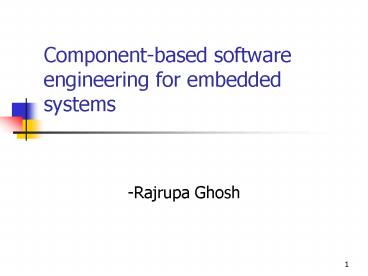Componentbased software engineering for embedded systems PowerPoint PPT Presentation
1 / 11
Title: Componentbased software engineering for embedded systems
1
Component-based software engineering for embedded
systems
- -Rajrupa Ghosh
2
Outline
- Component
- Component Based Software Engineering
- Main Principles of CBSE
- CBSE for Embedded Systems
- Advantages of using CBSE for Embedded Systems
- CBSE Models
3
What is a component?
- A software component is
- basic units of encapsulated behavior
- with contractually specified interfaces
- and explicit context dependencies only
- A software component
- can be deployed independently
- it is subject to composition by third party
4
Component-based Software Engineering
- Software is structured into components and
systems are constructed by composing and
connecting these components
5
Main Principles of CBSE
- Reusability
- Substitutability
- Composability
- Extensibility
- -Extending components that are part of a
system - -Increase the functionality of individual
components
6
What are embedded systems
- A computer system that is part of a larger
- system and performs some of the requirements
of that system
7
Central Technical Concepts
- Software components
- - well specified interfaces, unnecessary
functionality removed, - scarcer usage of resources,
memory consumptions, reliability, stability,
dependability - Component Models
- - Impose design restrictions to make systems
more predictable with respect to important
properties in the domain - Component Frameworks
- - runtime systems that supports components
execution by - handling component interaction
and invocation - - light weighted and use predictable
mechanisms - Component Technology
- -Concrete implementations of component models and
frameworks - Eg. COM, EJB, .NET
8
Advantages
- Reduced development time
- component reuse
- parallel development of components
- Maintainance well supported
- Adding new or upgrading existing components
- Extendable interfaces of components
- Enhanced testing and debugging
- Unit testing
- Monitor interfaces to ensure correct behavior
9
Widely used component models for embedded systems
- Telecommunications industry- Corba
- Process industry- COM/DCOM, .Net
- Added functionalities- OPC (OLE process control
Foundation)
10
References
- http//www.mrtc.mdh.se/publications/0838.pdf
- www.snart.org/conference/2004/ Ivica-PresentationS
nartSeminar2004.pdf - http//www.cis.ksu.edu/jung/Publications/dwyer-al
.savcb03.pdf - Component Based Software Engineering Putting the
Pieces Together by George T. Heineman, William T.
Councill
11
- Questions?

